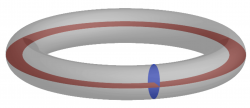Flux surface: Difference between revisions
No edit summary |
|||
| Line 19: | Line 19: | ||
:<math>F = \int_S{\vec B \cdot \vec n dS}</math> | :<math>F = \int_S{\vec B \cdot \vec n dS}</math> | ||
[[File:Flux_definition.png|250px|thumb|right|Diagram showing the surfaces defining the poloidal (red) and toroidal (blue) flux]] | |||
When ''B'' is a magnetic field with toroidal nested flux surfaces, two magnetic fluxes can be defined from two corresponding surfaces. | When ''B'' is a magnetic field with toroidal nested flux surfaces, two magnetic fluxes can be defined from two corresponding surfaces. | ||
<ref>R.D. Hazeltine, J.D. Meiss, ''Plasma Confinement'', Courier Dover Publications (2003) ISBN 0486432424</ref> | <ref>R.D. Hazeltine, J.D. Meiss, ''Plasma Confinement'', Courier Dover Publications (2003) ISBN 0486432424</ref> | ||
Revision as of 17:39, 19 August 2009
A given smooth surface S with normal n is a flux surface of a smooth vector field B when
everywhere. Defining a scalar flux function (f) such that its value is constant on the surface S, this can be rewritten
In three dimensions, the only closed flux surface corresponding to a non-vanishing vector field is a topological toroid. [1] This fact lies at the basis of the design of magnetic confinement devices.
If a single vector field B has several such toroidal flux surfaces, they must necessarily be nested (since they cannot intersect) or be disjoint. Ignoring the latter possibility, it then makes sense to use the function f to label the flux surfaces, so f may be used as an effective "radial" coordinate. Each toroidal surface f encloses a volume V(f). The surface corresponding to an infinitesimal volume V is essentially a line that corresponds to the toroidal axis (called magnetic axis when B is a magnetic field).
The flux F through an arbitrary surface S is given by
When B is a magnetic field with toroidal nested flux surfaces, two magnetic fluxes can be defined from two corresponding surfaces. [2] The poloidal flux is defined by
where Sp is a ring-shaped ribbon stretched between the magnetic axis and the flux surface f, and the toroidal flux by
where St is a poloidal section of the flux surface. It is natural to use ψ or φ to label the flux surfaces instead of the unphysical label f.
See also
References
- ↑ The Poincaré-Hopf Theorem.
- ↑ R.D. Hazeltine, J.D. Meiss, Plasma Confinement, Courier Dover Publications (2003) ISBN 0486432424





